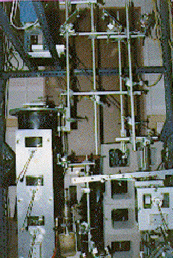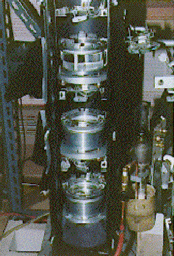
Brief Description: This is a project jointly supported by NASA's Upper Atmospheric Research Program and NSF's Atmospheric Chemistry division. It is part of an ongoing program of OH measurement and analysis that was initiated over 20 years ago by C. R. Burnett. The OH radical is extremely important to the photochemistry of the atmosphere; measurements of atmospheric OH are thus crucial to understanding natural and anthropogenic change in the Earth's atmosphere.
Methods: These are ground-based OH column measurements of the resonant absorption of sunlight at 308 nm (near ultraviolet). Observations of a single electronic-rotation absorption line are made using a custom designed, high resolution-luminosity product spectrometer.
PEPSIOS: Poly-Etalon, Pressure Scanned, Interferometric Optical
Spectrometer. 
A close-up of 3 of the Fabry-Perot interferometers:

There are actually 4 interferomenters and 2 reflection gratings used in this instrument.
Data:
You can view a sample spectral scan obtained in April, 1996.
Here are monthly averaged data since April of 1996.
The 1996 average diurnal behavior at New Mexico Tech was consistent with the 1980-1990 average from Fritz Peak Colorado, but was about 10% higher for near-overhead sun conditions.